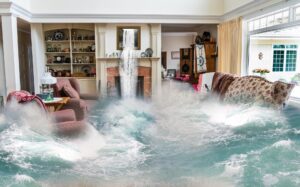How to Prepare for a Flood
No homeowner wants to deal with the destruction that a flood can bring, but the fact is that these natural disasters are a frequent occurrence in certain areas of the country and a possibility just about everywhere else. It’s best to always be prepared for the worst.
Any instance where water covers land that’s normally dry can be considered a flood. Floods can happen anywhere in the U.S., although locations by the coast or a river, lake, or stream are particularly vulnerable to flooding. Large, storm-prone cities, whose paved surfaces prevent water absorption, also face flooding problems.
There’s not much you can do to keep a flood from occurring, but there are steps you can take to minimize the damage. Here’s how to prepare your home for a flood.
Find Out if Your House is in a Flood Zone
A flood zone is an area determined by the Federal Emergency Management Agency (FEMA) to be susceptible to flooding. You can look up your community on the FEMA site to determine your flood zone status. More than 20,000 U.S. communities are in flood zones, and the zones are categorized as either high risk (labeled as A or V on flood maps), moderate to low risk (B, C, or X), or undetermined (the risk exists, but detailed analysis hasn’t yet been conducted; labeled as D).
Homeowners in high-risk areas are required by mortgage lenders to purchase flood insurance for their homes. But even if you’re in a flood zone where it’s not mandatory to buy flood insurance, this is something you should consider doing. Just a few inches of water in your basement can cause plenty of damage to your home and end up being very costly.
Flood-Proof Your House as Best as You Can
If you live in a flood zone, you may want to consider elevating the main utilities in your house, such as the electrical and heating systems—or perhaps even elevating your entire home. It’s possible to raise an existing structure on piles so that the lowest level of the house is safely situated above the flood line.
The basement, if you have one, is the most vulnerable part of the house when it comes to flooding. Consider having the electrical outlets and panels moved to a higher location, and applying a sealing product such as DryLok to the walls to guard against water damage. If you often deal with water seeping in from the ground, consider installing a sump pump, which will help remove groundwater and keep your basement from flooding.
Know What to Do If Your Home Gets Flooded
There are a few things you should learn how to do around the house before you find yourself in a situation where you have to act.
1. Shut Off Electricity and Utilities
Find out where the main power breaker is located and learn how to turn it off to prevent accidental electrocution—water and electricity do not mix. Also, figure out how to shut off the main gas and water valves so these utilities don’t become a hazard in the event of a flood. Practice doing these things before the disaster actually strikes so that if the time comes, you’ll be able to spring into action.
2. Have an Evacuation Plan
Have an evacuation plan ready, in case the worst-case scenario occurs. Map out a route for leaving the area, and decide in advance where you’ll be going. Also come up with a few backup routes, in case the main roads get flooded or become congested with other evacuees.
3. Stock Up on Supplies
Consider what you’ll need if you have to live in your home for a while after a flood. Always keep battery-operated flashlights, canned food, drinking water, and medication handy, and make sure you have enough of these supplies to last you and your family at least three days.
Prep Your Home for an Imminent Storm
If heavy rainfall is on its way and flooding is likely, there are a number of things you can do to minimize your losses.
- Move any irreplaceable or valuable items from the lower floors of your home to the upper floors. If it’s possible, bring up your lower-level furniture as well.
- Secure any loose items around your home that might get swept away, such as lawn furniture and trash cans, by bringing them all indoors.
- Shut off the propane tank, and unplug your appliances and devices to prevent them from shorting in the event of a power surge.
- Make sure your cellphone is fully charged ahead of the storm, in case the power goes out.
- Clean out the debris from your gutters and downspouts and make sure they’re all working properly to divert water away from your home. This will help reduce the chances of water accumulation around the house.
Use Sandbags to Keep Water Out
If you’re worried about water coming into your house through exposed entryways such as the garage door or basement windows, you can sandbag the area. Sandbagging is a technique for keeping water out, where you obstruct the entryway by building a wall or pyramid of sandbags around it.
You can use traditional sandbags made of burlap and sand for this purpose, but there are also many newer products on the market, such as self-inflating barriers, which can be easier to maneuver and store.
CREDIT: https://www.thisoldhouse.com/natural-disasters/22275081/preparing-for-a-flood

